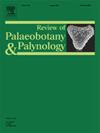假马齿苋花粉形态变异及进化趋势
IF 1.7
3区 地球科学
Q2 PALEONTOLOGY
引用次数: 0
摘要
假马齿苋是一个形态变异较大的植物属,前人对其孢粉学的研究很少。因此,本研究的目的是描述具有潜在分类意义的孢粉学特征,并讨论其系统意义。此外,还分析了该属孢粉学特征的演化及其系统利用。对花粉粒进行乙酰化处理,光镜、扫描电镜观察分析,测量拍照。基于描述性和多变量统计进行定性和定量数据分析。在前人系统发育的基础上,采用随机特征映射的方法进行孢粉特征的祖先重建。对22个分类群的花粉形态进行了首次描述。假马齿苋的花粉形态有助于该属的分类学研究,因为它允许形成与先前提出的部分一致的群。复合开口(三孔)被认为是一个祖先的特征状态,以及盾状外壁,小尺寸和延长的球体形状。假马齿苋属为全花粉属,花粉孔的数量和类型使我们能够区分出三种花粉类型,这些花粉类型与分子系统发育确定的亚支系一致。本文章由计算机程序翻译,如有差异,请以英文原文为准。

Morphological variation and evolutionary trends in pollen of Bacopa (Gratioleae-Plantaginaceae)
Bacopa (Gratioleae-Plantaginaceae) is a plant genus with great morphological variability and little previous information on its palynology. Thus, the aim of the present study is to describe palynological characters of potential taxonomic significance for the delimitation of Bacopa species and to discuss their systematic implications. In addition, the evolution and systematic utility of palynological characters in the genus were also analyzed. The pollen grains were acetolyzed, observed and analyzed under light and scanning electron microscopy, measured and photographed. Analyses based on qualitative and quantitative data were performed based on descriptive and multivariate statistics. Also, the ancestral reconstruction of palynological characters was carried out by stochastic character mapping, based on previous phylogenies. The pollen morphology of 22 taxa was described for the first time. The pollen morphology of Bacopa contributes to taxonomic studies of the genus because it allows the formation of groups that coincide with previously proposed sections. The compound opening (tricolporate) was considered as an ancestral character state, as well as the tectate exine, small size and prolate-spheroidal shape. Bacopa is confirmed as an eurypalynous genus, the number and type of apertures allowed us to differentiate three pollen types that coincide with the subclades determined by molecular phylogeny.
求助全文
通过发布文献求助,成功后即可免费获取论文全文。
去求助
来源期刊
CiteScore
3.50
自引率
21.10%
发文量
149
审稿时长
6 months
期刊介绍:
The Review of Palaeobotany and Palynology is an international journal for articles in all fields of palaeobotany and palynology dealing with all groups, ranging from marine palynomorphs to higher land plants. Original contributions and comprehensive review papers should appeal to an international audience. Typical topics include but are not restricted to systematics, evolution, palaeobiology, palaeoecology, biostratigraphy, biochronology, palaeoclimatology, paleogeography, taphonomy, palaeoenvironmental reconstructions, vegetation history, and practical applications of palaeobotany and palynology, e.g. in coal and petroleum geology and archaeology. The journal especially encourages the publication of articles in which palaeobotany and palynology are applied for solving fundamental geological and biological problems as well as innovative and interdisciplinary approaches.

 求助内容:
求助内容: 应助结果提醒方式:
应助结果提醒方式:


